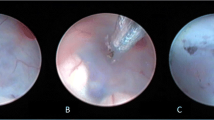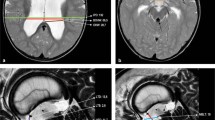Abstract
Purpose
This study describes the results of septostomy (SPT) in terms of success and analysis of follow-up in a series of pediatric patients diagnosed with unilateral ventricular hydrocephalus (UHV) and biventricular hydrocephalus (BVH).
Methods
A total of 29 pediatric patients diagnosed with UVH or BVH were included in this study. In UVH, a neuroendoscopic SPT was performed (sometimes accompanied by NEFPFMO). In those diagnosed with BVH, an SPT combined with VPS was carried out. Demographic, etiological, clinical, and diagnostic variables and percentage of treatment success were collected.
Results
SPT was successful during follow-up when no VPS was required in UVH and only unilateral VPS was implanted in BVH. At the time of surgery, 16 patients needed a ventriculoperitoneal shunt. The first SPT was successful in 22 patients, requiring a second surgery in 7 patients, from the oncology group diagnosed with BHV.
Conclusions
The surgical management of UVH and BVH still has some disclosure points to be reviewed. However, SPT seems to be a secure, non-traumatic, and efficient procedure.
Similar content being viewed by others
Availability of data and material
The data that support the findings of this study are available from the corresponding author, KA, upon reasonable request.
References
Dott NM (1927) A case of left unilateral hydrocephalus in an infant. Operation—cure. Brain 50(3–4):548–561. https://doi.org/10.1093/brain/50.3-4.548
Oi S, Matsumoto S (1985) Pathophysiology of nonneoplastic obstruction of the foramen of Monro and progressive unilateral hydrocephalus. Neurosurgery 17(6):891–896. https://doi.org/10.1227/00006123-198512000-00003
Schonauer C et al (2014) Adult idiopathic occlusion of Monro foramina: intraoperative endoscopic reinterpretation of radiological data and review of the literature. Br J Neurosurg 28(6):717–721. https://doi.org/10.3109/02688697.2014.918580
Cochrane D, Kestle J, Steinbok P, Evans D, Heron N (1995) Model for the cost analysis of shunted hydrocephalic children. Pediatr Neurosurg 23(1):14–19. https://doi.org/10.1159/000120930
Piatt Jr JH, Carlson CV (1993) A search for determinants of cerebrospinal fluid shunt survival: retrospective analysis of a 14-year institutional experience. Pediatr Neurosurg 19(5):233–241; discussion 242. https://doi.org/10.1159/000120738
Sainte-Rose C, Piatt JH, Renier D, Pierre-Kahn A, Hirsch JF, Hoffman HJ, Humphreys RP, Hendrick EB (1991) Mechanical complications in shunts. Pediatr Neurosurg 17(1)2–9. https://doi.org/10.1159/000120557
Surchev J, Georgiev K, Enchev Y, Avramov R, Di Rocco C (2002) Extremely rare complications in cerebrospinal fluid shunt operations. J Neurosurg Sci 46(2):100–102; discussion 103
Tamburrini G, Frassanito P, Massimi L, Caldarelli M, Di Rocco C (2012) Endoscopic septostomy through a standard precoronal ventricular access: feasibility and effectiveness. Acta Neurochir (Wien) 154(8):1517–1522. https://doi.org/10.1007/s00701-012-1381-6
Etus V, Ceylan S (2005) The role of endoscopic third ventriculostomy in the treatment of triventricular hydrocephalus seen in children with achondroplasia: report of two cases. J Neurosurg Pediatr 103(3):260–265. https://doi.org/10.3171/ped.2005.103.3.0260
Aldana PR, Kestle JRW, Brockmeyer DL, Walker ML (2003) Results of endoscopic septal fenestration in the treatment of isolated ventricular hydrocephalus. Pediatr Neurosurg 38(6):286–294. https://doi.org/10.1159/000070412
Hamada H, Hayashi N, Kurimoto M, Umemura K, Hirashima Y, Endo S (2003) Neuroendoscopic septostomy for isolated lateral ventricle. Neurol Med Chir (Tokyo) 43(12):582–587; discussion 588. https://doi.org/10.2176/nmc.43.582
Vinas FC, Castillo C, Diaz FG (1998) Microanatomical considerations for the fenestration of the septum pellucidum. Minim Invasive Neurosurg MIN 41(1):20–26. https://doi.org/10.1055/s-2008-1052009
Giammattei L, Aureli V, Daniel R-T, Messerer M (2018) Neuroendoscopic septostomy: Indications and surgical technique. Neurochirurgie 64(3):190–193. https://doi.org/10.1016/j.neuchi.2018.02.004
Mohammad MH, Diaz RJ (2017) Technical and anatomical aspects of endoscopically assisted septostomy in unilateral ventriculoperitoneal shunt placement for the management of isolated lateral ventricles. Interdiscip Neurosurg 10:32–36. https://doi.org/10.1016/j.inat.2017.05.003
Oertel JM, Schroeder HW, Gaab MR (2009) Endoscopic stomy of the septum pellucidum: indications, technique, and results. Neurosurgery 64(3):482–491; discussion 491–493. https://doi.org/10.1227/01.NEU.0000338944.42411.67
Gaab MR, Schroeder HW (1999) Neuroendoscopic approach to intraventricular lesions. Neurosurg Focus 6(4):e5
Gangemi M et al (2002) Endoscopic fenestration of symptomatic septum pellucidum cysts: three case reports with discussion on the approaches and technique. Minim Invasive Neurosurg MIN 45(2):105–108. https://doi.org/10.1055/s-2002-32483
Rohde V, Reinges MH, Krombach GA, Gilsbach JM (1998) The combined use of image-guided frameless stereotaxy and neuroendoscopy for the surgical management of occlusive hydrocephalus and intracranial cysts. Br J Neurosurg 12(6):531–538. https://doi.org/10.1080/02688699844385
Gumprecht H, Trost HA, Lumenta CB (2000) Neuroendoscopy combined with frameless neuronavigation. Br J Neurosurg 14(2):129–131. https://doi.org/10.1080/02688690050004552
Rohde V, Behm T, Ludwig H, Wachter D (2012) The role of neuronavigation in intracranial endoscopic procedures. Neurosurg Rev 35(3):351–358. https://doi.org/10.1007/s10143-011-0369-7
Heilman CB, Cohen AR (1991) Endoscopic ventricular fenestration using a “saline torch.” J Neurosurg 74(2):224–229. https://doi.org/10.3171/jns.1991.74.2.0224
Oi S, Hidaka M, Honda Y, Togo K, Shinoda M, Shimoda M, Tsugane R, Sato O (1999) Neuroendoscopic surgery for specific forms of hydrocephalus. Childs Nerv Syst ChNS Off J Int Soc Pediatr Neurosurg 15(1):56–68. https://doi.org/10.1007/s003810050330
Hayashi N, Hamada H, Hirashima Y, Kurimoto M, Takaku A, Endo S (2000) Clinical features in patients requiring reoperation after failed endoscopic procedures for hydrocephalus. Minim Invasive Neurosurg MIN 43(4):181–186. https://doi.org/10.1055/s-2000-11377
Author information
Authors and Affiliations
Contributions
Kevin Armas-Melián, Bienvenido Ros-López, Sara Iglesias-Moroño, and Miguel Ángel Arráez-Sánchez designed the study. Drs. Bienvenido Ros-López and Sara Iglesias-Moroño collected the sample data. Kevin Armas-Melián and Lenin Gómez-Barreno checked the database, wrote the manuscript, and made the tables. Dr. Lenin Gómez-Barreno was in charge of the methods. All authors reviewed and approved the manuscript.
Corresponding author
Ethics declarations
Ethics approval and consent to participate
This retrospective chart review study involving human participants was under the ethical standards of the institutional and national research committee and with the 1964 Helsinki Declaration and its later amendments or comparable ethical standards. The Human Investigation Committee (IRC) of the Regional University Hospital of Malaga in Spain approved this study. Written informed consent to engage was gotten from the parent/guardian.
Consent for publication
Written informed consent for publication was also gotten from the parent/guardian.
Conflict of interest
The authors declare that they have no conflict of interest.
Additional information
Publisher's Note
Springer Nature remains neutral with regard to jurisdictional claims in published maps and institutional affiliations.
Rights and permissions
Springer Nature or its licensor holds exclusive rights to this article under a publishing agreement with the author(s) or other rightsholder(s); author self-archiving of the accepted manuscript version of this article is solely governed by the terms of such publishing agreement and applicable law.
About this article
Cite this article
Armas-Melián, K., Ros, B., Gómez-Barreno, L. et al. Neuroendoscopic septostomy in unilateral and bilateral ventricular hydrocephalus. Childs Nerv Syst 39, 197–203 (2023). https://doi.org/10.1007/s00381-022-05690-6
Received:
Accepted:
Published:
Issue Date:
DOI: https://doi.org/10.1007/s00381-022-05690-6




